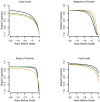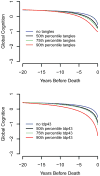Temporal course of neurodegenerative effects on cognition in old age
- PMID: 27111293
- PMCID: PMC4988317
- DOI: 10.1037/neu0000282
Temporal course of neurodegenerative effects on cognition in old age
Abstract
Objective: To test the hypothesis that different forms of neurodegeneration are differentially related to longitudinal cognitive trajectories in old age.
Methods: Participants are 420 older persons from 2 clinical-pathologic studies without cognitive impairment at study onset. They completed a battery of 17 cognitive tests annually for a minimum of 5 years, died, and underwent a neuropathologic examination to quantify neuronal neurofibrillary tangles and transactive response DNA-binding protein 43 (TDP-43) pathology and to identify Lewy bodies and hippocampal sclerosis. The authors used sigmoid mixed models based on the 4-parameter logistic distribution to decompose nonlinear global cognitive trajectories into components and assess the relation of each neuropathologic marker to each trajectory component.
Results: Cognitive function was assessed for a mean of 10.5 years before death. In the absence of pathology, global cognition was relatively stable before declining moderately in the last 3 to 4 years of life. Tangles were related to all trajectory components except initial level. TDP-43 pathology was the only marker related to initial level of function. It was also associated with an earlier midpoint of decline but not to slope of decline. Hippocampal sclerosis was related to an earlier midpoint of decline and more rapid slope of decline. Lewy bodies were associated with faster slope of decline and lower level of function proximate to death.
Conclusion: Neurodegenerative processes are differentially related to cognitive trajectories, with TDP-43 pathology most potently impacting incipient cognitive decline, AD pathology and hippocampal sclerosis affecting the progression of cognitive decline, and Lewy bodies impacting terminal decline. (PsycINFO Database Record
(c) 2016 APA, all rights reserved).
Figures





References
-
- Albert M, Scherr P, Taylor J, Evans D, Funkensten H. Use of brief cognitive tests to identify individuals in the community with clinically diagnosed Alzheimer’s disease. International Journal of Neuroscience. 1991;57:167–178. - PubMed
-
- Arai T, Mackenzie IR, Hasegawa M, Nonoka T, Nizato K, Tsuchiya K, … Akiyama H. Phosphorylated TDP-43 in Alzheimer’s disease and dementia with Lewy bodies. Acta Neuropathologica. 2009;117:125–136. - PubMed
MeSH terms
Substances
Grants and funding
LinkOut - more resources
Full Text Sources
Other Literature Sources
Medical

